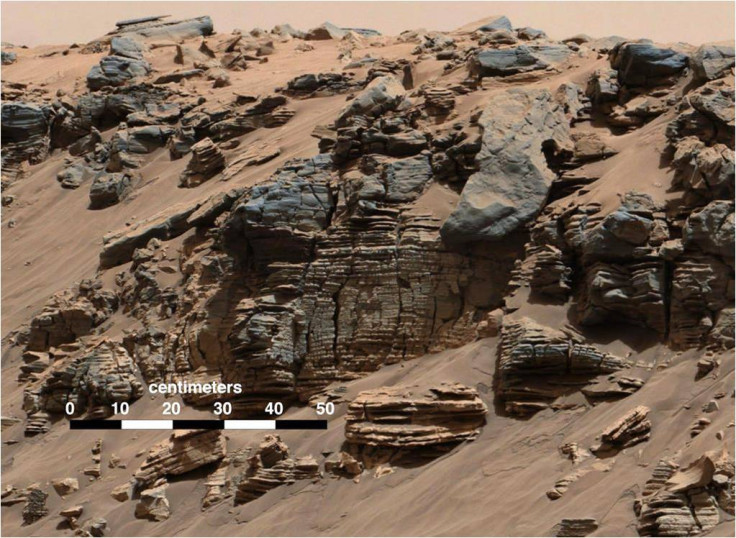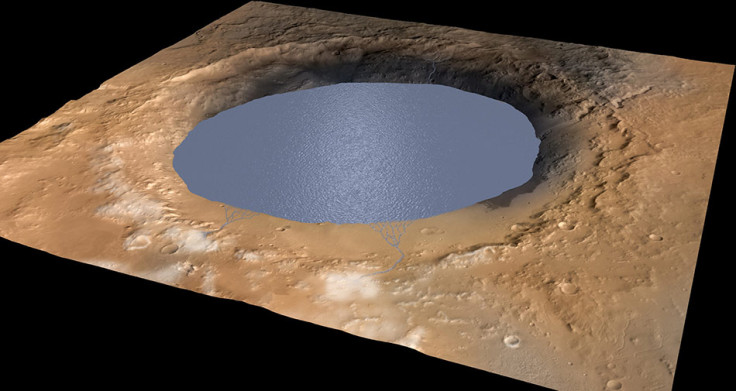Mars: Salty liquid water 'discovered' on Red Planet raises questions of alien life

Liquid water might have been discovered on the surface of Mars, raising the possibility of finding primitive forms alien life in the future.
Scientists have long known water exists on Mars in the form of ice, and in 2014 scientists found trace evidence of liquid water. But researchers have now found a type of salt in the soil that lowers the temperature at which water freezes, meaning it can exist in liquid form on the freezing surface. The salt – calcium perchlorate – was found by the Mars rover Curiosity in the Gale Crater.
Morten Bo Madsen, associate professor and head of the Mars Group at the Niels Bohr Institute at the University of Copenhagen, told IBTimes UK: "What's new in this study is that we have temperature and humidity measurements for a whole year so now we have sufficient data to show that water can be liquid in the form of brines. It's only at certain times of year that this happens – late winter and early spring."
Publishing their findings in the journal Nature, researchers said calcium perchlorate absorbs water vapour from the atmosphere under the right conditions.
Data from Curiosity's weather monitoring system shows how these conditions exist at night and just after sunrise in the winter. Humidity and temperature measurements allowed the team to estimate the amount of water absorbed, Madsen said in a statement.
He said: "When night falls, some of the water vapour in the atmosphere condenses on the planet surface as frost, but calcium perchlorate is very absorbent and it forms a brine with the water, so the freezing point is lowered and the frost can turn into a liquid.

"The soil is porous, so what we are seeing is that the water seeps down through the soil. Over time, other salts may also dissolve in the soil and now that they are liquid, they can move and precipitate elsewhere under the surface."
Alien life
Mars no longer has a magnetic field so it is not protected from radiation from the Sun. This means life on the surface is extremely unlikely – despite the presence of liquid water.
"This study shows that there's too little water, too dry, it's too cold and what we also know is that cosmic radiation is so intense, it's not a place where organisms like those found on Earth could survive," Madsen said.
Javier Martin-Torres, lead author of the study, told IBTimes UK the findings from the study point to future research into the special regions of Mars – areas scientists believe should be targeted because they may support Earth microbes inadvertently introduced.
Since liquid water could be present at such a low altitude in the Gale Crater where the perchlorate was found, Martin-Torres has high hopes liquid water could be found in regions across the planet. He also noted that through these salts there is a water cycle, with water being exchanged between the soil and the atmosphere.
He said: "Because it's happening in the night time – we are talking about the worst case scenario. We are in the crater of Mars. We know there are perchlorates all over the planet. If conditions for brine formation are in the crater, they should be in the rest of the planet. And the same for the water cycle and exchange with the atmosphere.
"We are hopeful of finding water on rest of the planet. In the crater it's the most unlikely place."

Martin-Torres said although there is no life on the surface, it could theoretically be found beneath the surface that has not been explored.
He said: "In the case of brine we found that this was at 15cm and beyond that we found the soil is hydrated but it's not brine, there isn't so much water. But below 50cm we don't know – we don't know what will be there."
Madsen added: "What we're looking for is traces of past life. I don't think it's probable that there's life there today. But if it is there we'd have to dig deep for it.
"We know there are organisms on Earth that can live in brines. We know there may be groundwater on Mars also. Now we know the brines can migrate, there may be a possibility there will be a salty water environment somewhere deep below the surface, but we won't be finding that with this mission, and it will be difficult to find in the future."
© Copyright IBTimes 2024. All rights reserved.






